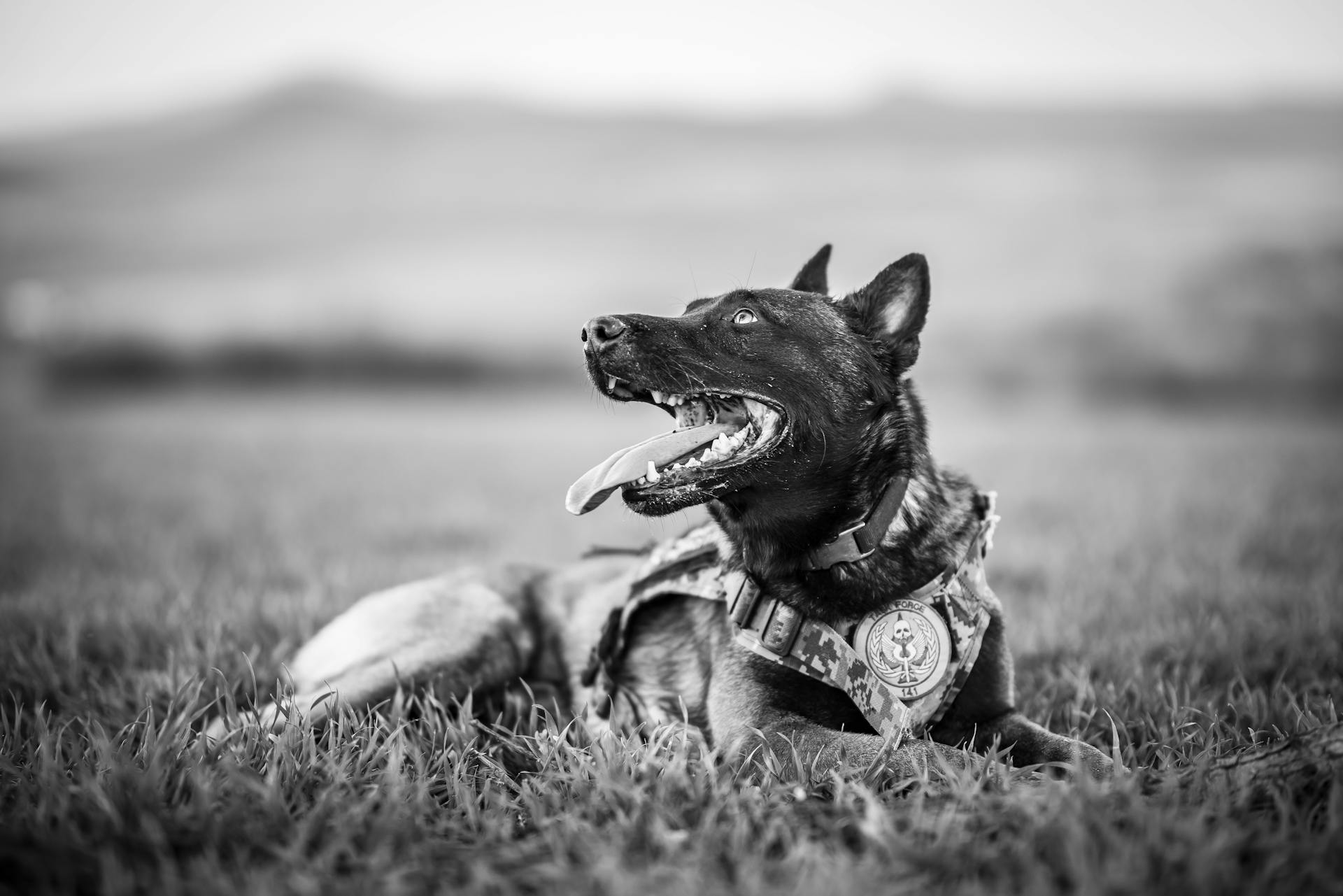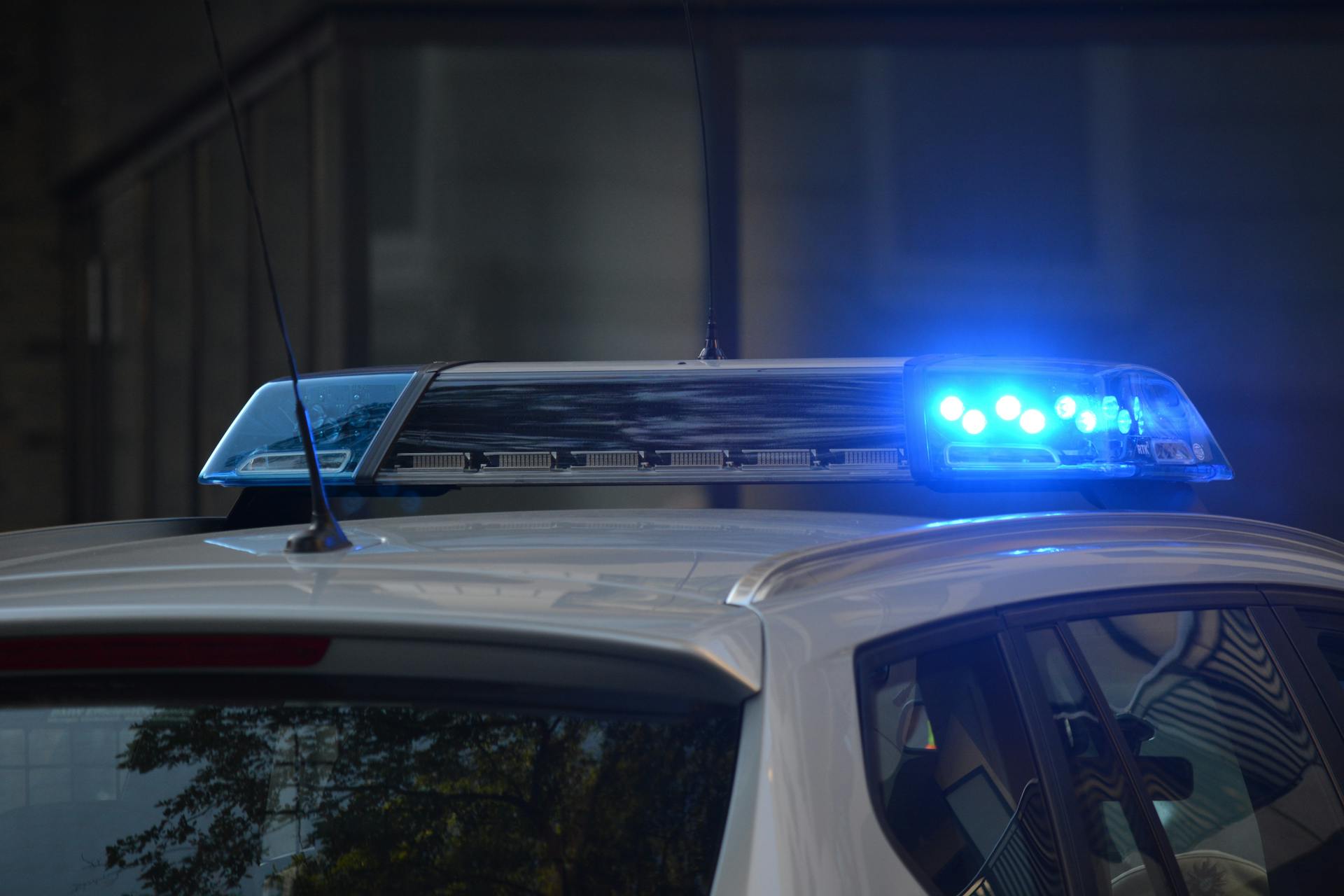
A drug dog's alert is a significant moment in the detection process. They use their highly developed sense of smell to detect specific substances.
To alert, a trained drug dog will often perform a specific behavior, such as sitting or pawing at the source of the odor.
You might enjoy: Dog Longevity Drug
How Sniffer Dogs Detect Drugs
Sniffer dogs have a unique way of detecting drugs - they're actually searching for their favourite toy. Their natural instinct is to hunt and seek out whatever they've been trained to find, which in this case is a certain toy associated with the smell of drugs.
A sniffer dog can cover a large area very quickly, 10 times faster than human officers. This is because they're trained to focus on their task and don't get distracted like humans do.
Their incredible sense of smell is what makes them so effective at detecting drugs, even when they're well hidden. For example, in 2002, a drugs dog in Australia foiled a woman's attempt to smuggle marijuana into a prison by detecting it hidden in a balloon smeared with coffee, pepper, and petroleum jelly.
Here's an interesting read: Dog Smell
Sniffer Dog Training
Sniffer dog training is a rigorous process that requires patience and dedication. Sniffer dogs are rewarded for any recognition of the target scent during the early stages of training.
The reward system is gradually phased out as the dog's skills progress, and the reward is only given when the dog responds with the correct reaction, such as sitting or barking.
Canine sniffer dogs and their handlers undergo extensive training for months to become certified. They are successful because of their ability to work as a team.
The training process involves testing and retraining throughout their careers to ensure their skills are reliable and up to standard. Dogs typically stay assigned to the handler they were trained with and the team gets re-tested together.
Sniffer dogs are trained to detect drugs in various settings, including airports, hospitals, and schools. They can be used to detect drugs on individuals, within buildings, open areas, and vehicles.
See what others are reading: Training a Dog to Protect
Can Dogs Smell Vape Carts?
Can dogs smell vape carts? Theoretically, yes, drug dogs would be capable of smelling vape cartridges containing THC extract.
Canine noses are incredibly sensitive, with some estimates suggesting they can detect scents 10,000 times weaker than what humans can smell.
If a drug dog were trained to respond to the aroma of cannabis, they would most likely also respond to the presence of a vape cart since their noses are so much more attenuated than the human equivalent.
Explore further: Drug Dogs Smell Delta 8 Disposables
Types of Alerts
There are two types of alerts a drug dog can make: aggressive and passive.
Aggressive alerts can be problematic, as seen with dogs trained to sniff out bombs. They might dig at the bomb, causing it to deploy.
Passive alerts are often preferred, as they allow the dog to signal the presence of the target without causing harm. For example, beagles used by the Department of Agriculture sit down when they smell prohibited fruits and vegetables.
Aggressive Alerting

Aggressive alerting is a type of alerting that can be overwhelming and distracting.
It's characterized by frequent and repetitive notifications, often with a sense of urgency that can be hard to ignore.
According to our discussion on "Types of Alerts", aggressive alerting can be triggered by critical events, such as system crashes or security breaches.
This type of alerting can be especially problematic for teams that rely on their alerting systems to stay on top of critical issues.
In some cases, aggressive alerting can lead to alert fatigue, where users become desensitized to even the most critical alerts.
By understanding the characteristics of aggressive alerting, you can take steps to prevent it from overwhelming your team.
Passive Alerting
Passive Alerting is a type of alert that's used in situations where a dog can't scratch or dig at what they've found.
This type of alert is essential in cases where a dog's aggressive behavior could cause harm, such as when searching for a bomb.

In these situations, a dog will use a passive alert to let their handler know they've found what they're looking for.
For example, beagles used by the Department of Agriculture to sniff out fruits and vegetables will sit down when they smell something they shouldn't.
This non-intrusive behavior allows people to continue going about their day without being disturbed.
Passive Alerting is a crucial aspect of drug dog training and other types of detection work.
By using a passive alert, dogs can effectively do their job without causing any disruption or potential harm.
Sources
- https://countysecurityuk.com/how-do-sniffer-dogs-detect-drugs/
- https://www.carlsonattorneys.com/news-and-update/drug-dog-violates-rights
- https://secretnaturecbd.com/blogs/news/can-drug-dogs-smell-carts
- https://www.3dk9detection.com/news/how-does-drug-dog-training-work
- https://justiceflorida.com/blog/how-to-determine-when-a-drug-dogs-alert-to-a-vehicle-is-reliable/
Featured Images: pexels.com


